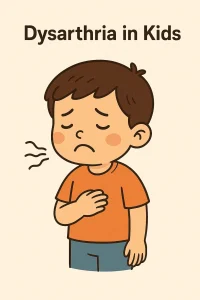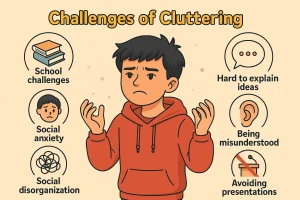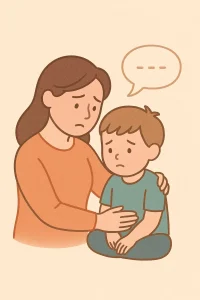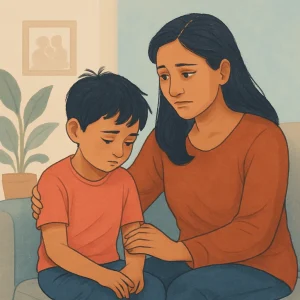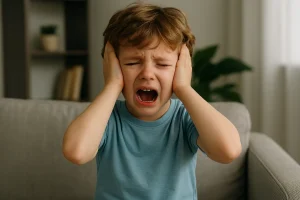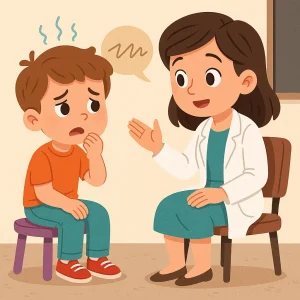The Psychological Impact of Still Face Syndrome on Children
Last Updated: January 17, 2025
Imagine this: You smile warmly at your child, expecting that happy little grin in return—but nothing happens. Now, flip the scenario. What if your child eagerly reaches out to you, only to find you sitting stone-faced? Moments like these can feel confusing and unsettling for children. This is what Still Face Syndrome is all about.
At its core, Still Face Syndrome refers to how a child responds emotionally and mentally when a parent or caregiver suddenly becomes emotionally unresponsive. It’s more than just a small parenting mishap—it’s a window into how early interactions shape your child’s emotional development.
What is Still Face Syndrome?
Still Face Syndrome is rooted in a fascinating psychological study known as the Still Face Experiment, conducted by Dr. Edward Tronick in the 1970s. This experiment offers insight into how babies react when their primary caregiver—typically a parent—suddenly stops responding emotionally. It’s a simple, yet powerful way to show the deep emotional connection children crave from their caregivers.
The Still Face Experiment: A Quick Overview
Picture this: A mother is sitting in front of her baby, interacting with smiles, coos, and playful gestures. The baby eagerly responds, delighted by this back-and-forth exchange. But then, suddenly, the mother’s expression goes blank. No smile, no movement—just an unresponsive, emotionless face.
At first, the baby tries everything to get the mother’s attention. They smile, wave their arms, and even point. But when none of these efforts succeed, frustration sets in. The baby may fuss, cry, or withdraw emotionally, giving up hope of getting a response.
Why Emotional Interaction Matters
The Still Face Experiment emphasizes the importance of consistent emotional engagement. When parents or caregivers are emotionally unavailable, even for a short period, children experience emotional confusion, anxiety, and distress. Repeated moments like this can create a pattern of emotional insecurity, leading to attachment issues and difficulties in emotional regulation as they grow.
Still Face Syndrome refers to these moments when a caregiver becomes unintentionally non-responsive—perhaps because they’re stressed, distracted, or overwhelmed. While occasional lapses happen to every parent, frequent emotional disconnection can take a toll on a child’s psychological development.
The Psychological Impact of Still Face Syndrome on Children
Children depend on emotional exchanges—like smiles, giggles, and hugs—with their parents. But when these responses are missing, even for a moment, it can leave kids feeling confused, stressed, and disconnected. Over time, these gaps in interaction can impact their emotional well-being and development. Let’s explore how Still Face Syndrome affects children.
1. Emotional Detachment and Confusion
Kids expect a reaction when they reach out—whether through a smile or a giggle. But when a parent doesn’t respond, the child feels lost.
- Confusion:
Imagine a child thinking, “Why isn’t my parent smiling back? Did I do something wrong?” This confusion can make kids stop trying to connect, leading to emotional detachment. - Insecurity:
When emotional feedback is missing too often, children start to feel unsure. This insecurity can stay with them, making it hard to form strong emotional bonds in the future.
2. Anxiety and Stress
When children can’t get a response from their caregiver, they feel stressed. They might try harder by crying or acting out. If their efforts don’t work, they may give up and withdraw.
- Signs of Stress:
- Crying or fussing
- Frustration or tantrums
- Becoming quiet or distant
- Long-Term Anxiety:
If emotional needs are unmet too often, kids may carry anxiety into adulthood. They might struggle with trust and feel uneasy in close relationships.
3. Impact on Parent-Child Bonding
Parent-child bonding happens through small moments—eye contact, cuddles, or shared smiles. When these moments are missed too often, it weakens the bond.
- Emotional Distance:
Children may feel disconnected if they can’t predict how their parents will react. They might become either clingy or distant, unsure if they can rely on others. - Attachment Issues:
Over time, these patterns can lead to attachment problems. Kids might struggle with trust, finding it hard to connect emotionally with others later in life.
4. Delayed Emotional Development
Kids learn emotions by interacting with their caregivers. When these interactions are missing, their ability to understand and express emotions can slow down.
- Trouble Expressing Emotions:
Children who don’t get regular emotional feedback may struggle to say how they feel. They might seem quiet, frustrated, or even withdrawn. - Challenges in Recognizing Emotions:
Without enough emotional cues, kids may find it hard to understand how others feel. This can make it difficult for them to fit into social situations or make friends. - Developmental Risks:
If emotional disconnection happens too often, it could contribute to developmental challenges—like difficulty with social skills or regulating emotions.
Also Read: The Importance of Baby Cues: How to Prevent Still Face Syndrome
Signs Your Child May Be Affected by Still Face Syndrome
It’s natural for children to have emotional ups and downs. But if you’ve noticed your child withdrawing or becoming irritable more frequently, it could be a sign of Still Face Syndrome. Knowing what to look for can help you step in early and support your child’s emotional health. Let’s walk through some key behaviors to watch for.
1. Changes in Behavior: Withdrawal or Irritability
When children feel emotionally disconnected, they may respond in two ways: withdrawal or irritability.
- Withdrawal:
Your child might avoid eye contact, seem uninterested in play, or become unusually quiet. They could spend more time alone, pulling away from family or activities they used to enjoy. - Irritability:
Some children react to emotional gaps with frustration. You might notice more tantrums, sudden bursts of anger, or mood swings that seem out of place.
2. Difficulty Forming Emotional Connections
One of the long-term signs of Still Face Syndrome is difficulty building relationships. Children affected by emotional disconnection may struggle to connect with:
- Parents or siblings: They might hesitate to seek comfort or share their feelings.
- Friends and peers: Your child may avoid social interactions, finding it hard to make friends or engage in group activities.
3. Lack of Responsiveness to Emotional Cues
Children learn to recognize emotions through consistent interactions—like smiling back when someone smiles at them. If your child has experienced frequent emotional disconnection, they may stop responding to these emotional cues.
- What to look for:
- No visible reaction to praise, smiles, or playful gestures.
- Not seeking comfort when upset, even when a caregiver offers it.
- Difficulty understanding or reacting to others’ emotions, such as sadness or happiness.
Comparison of Emotional Behaviors – Healthy vs. Affected by Still Face Syndrome
| Behavior | Healthy Emotional Development | Affected by Still Face Syndrome |
|---|---|---|
| Eye Contact | The child makes and holds regular eye contact to connect emotionally with parents and others. | The child avoids eye contact or looks away frequently, signaling emotional discomfort. |
| Emotional Response | Responds to smiles and playful gestures with laughter, smiles, or excitement, showing engagement. | The child withdraws from interactions or becomes frustrated quickly when emotions aren’t reciprocated. |
| Social Interaction with Peers | Enjoys playing with friends and can bond easily, building relationships through shared activities. | Finds it hard to connect with peers, often avoiding social interaction or showing disinterest. |
| Responding to Emotional Cues | Recognizes when others are happy, sad, or upset, and responds appropriately with empathy or understanding. | Struggles to understand emotions, often ignoring or misinterpreting emotional signals from others. |
Know more about on Identifying and Managing Still Face Syndrome in Children
How to Address the Impact of Still Face Syndrome
The good news is that Still Face Syndrome doesn’t have to leave a lasting mark. Small changes can make a big difference in rebuilding emotional connections with your child. In this section, we’ll explore practical strategies that help restore those bonds, promote emotional growth, and offer guidance on when to seek professional support.
Responsive Parenting Techniques
One of the most effective ways to counteract the effects of Still Face Syndrome is through responsive parenting. By being present and emotionally engaged, you signal to your child that they are seen, heard, and valued.
- Maintain Eye Contact and Smile:
A warm smile or gentle eye contact reassures your child, helping them feel emotionally safe. These small gestures say, “I’m here, and I care.” - Engage Emotionally:
Use words, touch, or playful gestures to connect with your child. Whether it’s sharing a laugh or soothing them when upset, emotional engagement strengthens your bond. - Set Aside Distractions:
It’s easy to get caught up in everyday distractions like phones or work. But even brief moments of undivided attention—without screens—can make a significant impact. When interacting with your child, be fully present to show them they matter.
Reinforce Positive Interactions
Reinforcing positive emotional exchanges helps children feel more connected and teaches them to express their feelings confidently.
- Play Games with Emotional Cues:
Games like peekaboo or mirroring each other’s facial expressions teach children about emotional responses in a fun, engaging way. These activities also strengthen their ability to recognize emotions in others. - Encourage and Respond to Signals:
Pay attention to your child’s emotional cues—whether they’re showing excitement, sadness, or frustration. When you respond with empathy and understanding, it teaches them that their emotions are valid and important.
Seek Professional Help When Needed
Sometimes, the emotional impact of Still Face Syndrome might need additional support. Recognizing when to seek help can make a big difference in your child’s development.
- When to Consult a Child Psychologist or Therapist:
If your child shows signs of emotional withdrawal or attachment issues that persist, it may be time to seek professional advice. A child psychologist can help identify underlying concerns and provide tailored guidance. - Explore Speech or Developmental Therapy:
In some cases, emotional detachment may affect a child’s ability to express themselves or interact with others. Speech therapy or developmental interventions can support children struggling with communication or social skills.
Long-term Effects of Still Face Syndrome
While Still Face Syndrome may seem like a temporary issue, its impact can extend far into a child’s future. Without early intervention, children exposed to frequent emotional disconnection can develop long-term mental health challenges. Let’s explore some potential outcomes and why addressing these issues early is so important.
1. Potential Mental Health Outcomes
1.1 Anxiety and Depression:
Children who experience frequent emotional disconnection may grow up feeling insecure about their relationships. They might worry about whether others care about them or if their emotions will be acknowledged. This can lead to anxiety over time, making social interactions stressful and overwhelming.
As they enter their teenage or adult years, the lingering effects of unaddressed emotional disconnection can also contribute to feelings of hopelessness or sadness, increasing the risk of depression. These children might struggle to seek emotional support when needed, further isolating themselves.
1.2 Social Challenges:
Children affected by Still Face Syndrome often struggle with recognizing and responding to emotional cues, which are essential for forming friendships and maintaining relationships.
- They may find it hard to understand others’ emotions, making social interactions feel confusing.
- Some might become overly clingy, afraid of losing the little emotional connection they manage to build, while others may distance themselves, avoiding emotional closeness altogether.
2. Importance of Early Intervention
The good news is that these long-term effects are not set in stone. Early intervention can significantly reduce the psychological impact of Still Face Syndrome and help children develop healthy emotional skills.
- Rebuilding Emotional Bonds:
If you notice your child showing signs of withdrawal or irritability, it’s essential to reconnect with responsive interactions. Simple things like making eye contact, sharing a laugh, or offering comfort when they’re upset can make a big difference. - Professional Support:
In cases where emotional disconnection has deeply affected a child, consulting with a child psychologist or therapist can be helpful. If your child is struggling with communication, speech therapy or developmental interventions may also offer support. Visit Wellness Hub to explore tools designed to nurture emotional development.
Conclusion
Every small interaction—whether it’s a smile, a hug, or making eye contact—helps shape your child’s emotional well-being. Still Face Syndrome reminds us how important these moments of emotional connection are. Children feel safe and secure when they know their feelings matter, and even small efforts from parents can have a big impact on their development. Life gets busy, and moments of distraction happen to all of us. But what matters most is being mindful and reconnecting with your child when those moments arise. Simple changes, like spending time together without distractions or responding to their emotions, can make a huge difference. If you notice signs of emotional disconnection, it’s never too late to rebuild those bonds.
Frequently Asked Questions:
1. What is Still Face Syndrome?
Still Face Syndrome refers to how children react when a caregiver suddenly becomes emotionally unresponsive. This concept comes from the Still Face Experiment, where babies showed signs of distress when their parents stopped interacting with them emotionally.
2. How does Still Face Syndrome affect a child emotionally?
Children may feel confused, frustrated, or withdrawn when they don’t receive expected emotional responses. Over time, this can lead to emotional insecurity, anxiety, or difficulties forming relationships.
3. What are the signs of Still Face Syndrome in children?
Signs include withdrawal, irritability, and a lack of emotional responsiveness. Some children might struggle to build relationships with parents or peers or find it hard to express their emotions.
4. Can Still Face Syndrome cause mental health problems later in life?
Yes, if left unaddressed, children affected by Still Face Syndrome may experience long-term challenges, such as anxiety, depression, or social difficulties. Emotional disconnection can also impact their ability to form healthy relationships.
5. How can parents help children affected by Still Face Syndrome?
Parents can reconnect with their children through responsive parenting—making eye contact, smiling, and engaging in emotional conversations. Setting aside distractions during interactions is also crucial.
6. When should I seek professional help for my child?
If you notice persistent signs of emotional withdrawal, anxiety, or difficulty forming relationships, consulting a child psychologist or therapist can be beneficial. Speech therapy or developmental interventions may also help if the child struggles with communication.
7. How can I use games to improve emotional connection with my child?
Games like peekaboo or mirroring facial expressions are great ways to reinforce positive emotional exchanges. These activities teach children how to recognize and respond to emotional cues in a fun and engaging way.
8. Is it too late to repair emotional connections with my child?
It’s never too late to rebuild emotional bonds. Small, consistent efforts—like spending quality time together—can help restore trust and emotional security, no matter the child’s age.
9. Can emotional disconnection affect a child’s development?
Yes, repeated emotional disconnection can slow down a child’s emotional and social development. It may cause delays in recognizing emotions, expressing feelings, and building relationships with others, which can affect long-term mental well-being.
10. How does screen time affect emotional connection with children?
Excessive screen time can reduce opportunities for face-to-face emotional interactions between parents and children. Setting aside devices during family time ensures meaningful engagement and helps children feel emotionally connected and valued.
About Author:
Lasya Vooturi,
Clinical Psychologist (A) & Behavioral Therapist
Lasya holds a Professional Diploma in Clinical Psychology from Amity University, where she deepened her understanding of psychological principles from March 2023 to March 2024. With over a year of dedicated experience as a Behavioral Therapist, Lasya has honed her skills in applying effective therapy techniques tailored to individual needs. Fluent in Telugu, Hindi, and English, she is adept at connecting with a diverse range of clients, ensuring comprehensive communication and understanding. Lasya’s approach is grounded in empathy and scientific rigor, making her a trusted ally in navigating mental health challenges.
Book your Free Consultation Today
Parent/Caregiver Info:
Client’s Details:
* Error Message



